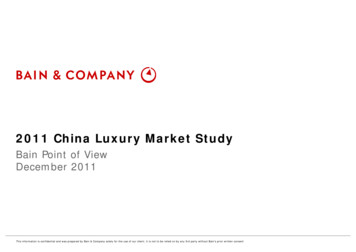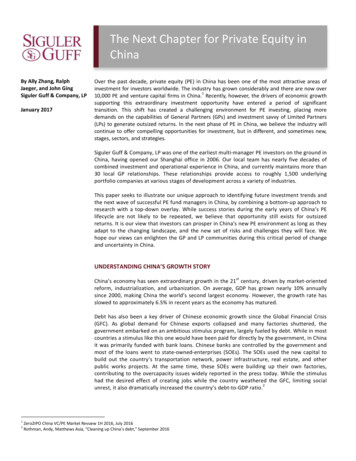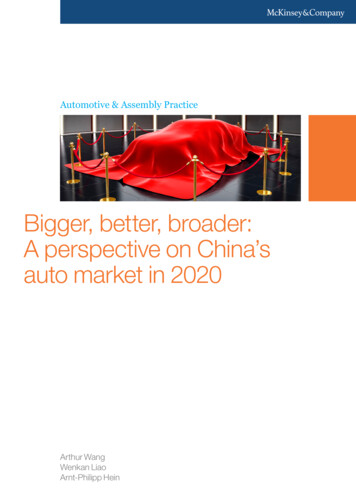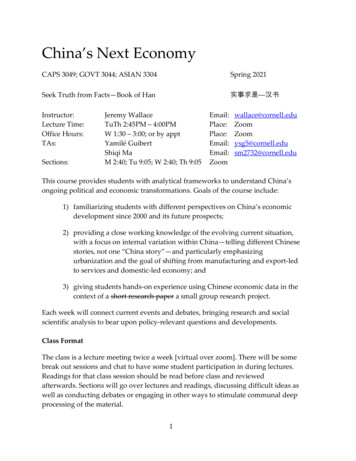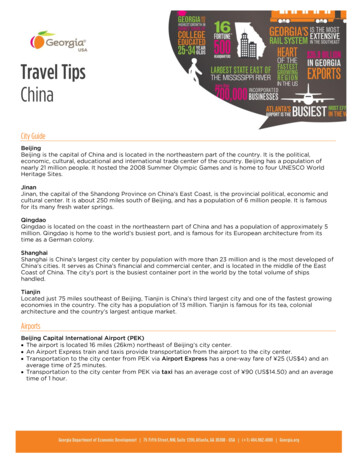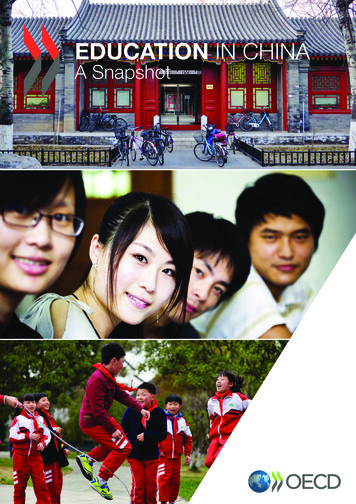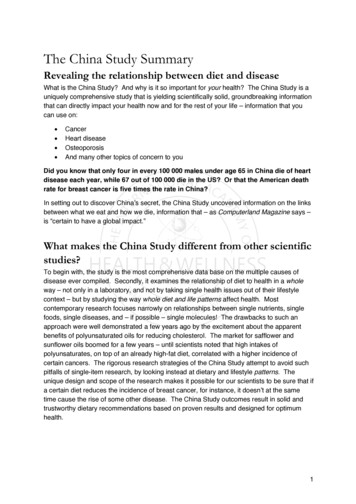
Transcription
The China Study SummaryRevealing the relationship between diet and diseaseWhat is the China Study? And why is it so important for your health? The China Study is auniquely comprehensive study that is yielding scientifically solid, groundbreaking informationthat can directly impact your health now and for the rest of your life – information that youcan use on: CancerHeart diseaseOsteoporosisAnd many other topics of concern to youDid you know that only four in every 100 000 males under age 65 in China die of heartdisease each year, while 67 out of 100 000 die in the US? Or that the American deathrate for breast cancer is five times the rate in China?In setting out to discover China’s secret, the China Study uncovered information on the linksbetween what we eat and how we die, information that – as Computerland Magazine says –is “certain to have a global impact.”What makes the China Study different from other scientificstudies?To begin with, the study is the most comprehensive data base on the multiple causes ofdisease ever compiled. Secondly, it examines the relationship of diet to health in a wholeway – not only in a laboratory, and not by taking single health issues out of their lifestylecontext – but by studying the way whole diet and life patterns affect health. Mostcontemporary research focuses narrowly on relationships between single nutrients, singlefoods, single diseases, and – if possible – single molecules! The drawbacks to such anapproach were well demonstrated a few years ago by the excitement about the apparentbenefits of polyunsaturated oils for reducing cholesterol. The market for safflower andsunflower oils boomed for a few years – until scientists noted that high intakes ofpolyunsaturates, on top of an already high-fat diet, correlated with a higher incidence ofcertain cancers. The rigorous research strategies of the China Study attempt to avoid suchpitfalls of single-item research, by looking instead at dietary and lifestyle patterns. Theunique design and scope of the research makes it possible for our scientists to be sure that ifa certain diet reduces the incidence of breast cancer, for instance, it doesn’t at the sametime cause the rise of some other disease. The China Study outcomes result in solid andtrustworthy dietary recommendations based on proven results and designed for optimumhealth.1
What is the China Study?The project, begun in 1983, is a collaborative effort between Cornell University, the ChineseAcademy of Preventive Medicine, the Chinese Academy of Medical Sciences, and OxfordUniversity, England, as well as scientists from the United States, China, Britain, France, andother countries.Why was rural China chosen as the site of the study? According to the principalinvestigators, China is a “living laboratory” for studying dietary patterns, unparalleledanywhere else in the world. This is because the Chinese, unlike our restless population,tend to spend their entire lives in the same area and eat the same kinds of locally grownfoods throughout their lives. Although we wouldn’t know if from the menus in most Chineserestaurants in the West, diets in China vary considerably from one region to another.Villagers on the mountainous north bank of the Yangtze River, for example, may rely onsteamed breads and sweet potatoes, while only 50 miles away on the rich farmlands to thesouth, villagers fill their plates with rice. And not only do the diets vary, most significantly sodo the disease rates.China offered perhaps the last place in the world where such a study could be undertaken.Here in the West, whether we live in Munich or Michigan, we might, in one day, eat aHonduras-grown banana for breakfast, a Mexican taco for lunch, a Chinese stir-fry fordinner, and an Italian pastry for dessert. And then the next day something completelydifferent. This, in addition to the fact that many of us move every year, makes such a studyimpossible in most countries. But, from a scientific point of view, China was perfect.The scientists were intrigued to find out if the varying diets in different parts of China wouldcorrelate to death rates from certain diseases. To find out, they set up one of the mostwidespread and massive scientific investigations ever devised.In 1983 and again in 1989, American, Chinese, and English researchers gatheredinformation on how people live and die in 65 counties in various parts of China. As theirbasis for selecting the counties, they used very comprehensive – and startling – date on 80million Chinese, compiled by the Chinese government, that showed that death rates fromspecific diseases varied sometimes several hundredfold from county to county. In choosingthe counties to be researched, the scientists made sure to include counties with theseunusually high or low death rates from seven different cancers: those of the nasopharynx,esophagus, stomach, liver, colorectal, lung and breast.2
People’s Republic of China Counties SurveyedWhat, is this genetically similar population, could explain the fact that men in one part ofChina died of esophageal cancer 435 times more frequently than did men in another part?Or that 20 times as many women in one county suffered from breast cancer than women in adifferent county?The counties surveyed stretched all the way across the Chinese land mass, from the farNorthwest to the Southern coastal regions, and – in the second survey – to Taiwan, addinganother 32 villages. The researchers sometimes had to travel for days across rough terrainin order to reach nomads, for example, on the Soviet border, or villagers in an oasis near theGobi Desert.In the 1989 survey, 10 200 Chinese and Taiwanese adults and their families were observed,measured, and interviewed for several days. Every piece of food they ate was noted. Urineand blood samples were taken. All in all, more than 1000 items of information werecollected on each person! Later, when the results of the China Study became available, theinformation was made available to county health officials all over China.What the Study FoundOne of the first things to emerge from the China Study data concerned the fact that certaingroups of diseases tend to occur in similar geographic and economic areas. Scientists havelong known that the people of underdeveloped nations tend to develop different diseasesthan do people in richer countries. In other words, diabetes and coronary heart diseaseoccur most frequently in geographic areas where cancer rates are also high, whilepneumonia and peptic ulcer appear with TB and rheumatic heart disease in other areas.The first group of diseases are known as “the diseases of affluence,” because they occurmost often in more affluent countries, and the second group are often called “diseases ofpoverty”.What impressed the researchers was that the data showed for the first time these clusters of“rich” and “poor” diseases in the same country. It seemed clear that there must be one setof common causes for each “disease grouping”. The China data offered the perfectopportunity to examine what these causes might be.3
What did they find? After examining several possible factors, the scientists found that the“rich” disease grouping – including the cancers and heart disease – was associated withtotal blood cholesterol and urea nitrogen.Disease GroupsDiseases of AffluenceColon cancer, lung cancer, breast cancer, leukemia, diabetes, coronary disease, braincancer (0-14 yr.), stomach cancer, liver cancerDiseases of PovertyPneumonia, intestinal obstruction, peptic ulcer, digestive diseases, nephritis, pulmonarytuberculosis, non-TB infectious, parasitic diseases, eclampsia, rheumatic heart disease,metabolic and endocrine diseases other than diabetes, diseases of pregnancy other thaneclampsiaWe’ll talk more about our findings on cholesterol below, so we’ll just briefly say here that ahigh blood level of cholesterol was consistently associated with many cancers –including leukemia, liver, colon, rectum, lung and brain.And what was particularly dramatic about these data was the fact that the highest cholesterollevels in rural China were near the lowest levels found in the US. The women in the villagesthat had the highest Chinese cholesterol levels – near our lowest American levels – also hadthe highest levels of cancers, heart disease, and diabetes, while the women in the villageswith the lowest cholesterol levels had the lowest levels of these diseases.Although most of us are familiar with cholesterol, the term “urea nitrogen” is another story.But, as the China Study data show, it is a most intriguing one with far-reaching effects on ourhealth. Urea nitrogen is what is left over from the metabolism of protein in the body.The more of this that we find in the blood, the higher our level of excess dietary protein.And, the China Study data show, the more meat, milk, and eggs we eat, the more likely weare to take in more protein than we need.The findings on cholesterol and urea were remarkable, because they showed that onlysmall intakes of animal products were associated with significant increases in chronicdegenerative diseases. And even more exciting, that the greater percentage of plant foodin our diet, the less the chance of getting these diseases. In other words, there’s nothreshold or stopping point at which the benefits of eating plant foods stop. Quite simply, theore you substitute plant foods for animal foods the healthier you are likely to be.Not surprisingly, it was the survey areas near the large Chinese cities that showed high ratesof the “rich” diseases. That’s because, as they become more affluent, the Chinese arebeginning to eat diets richer in oils and animal products – in Shanghai and Beijing eatingmeat has acquired a certain social cachet.4
Unfortunately, this gastronomic form of social climbing is just the diet that we now knowcauses so many of the diseases we suffer from in the West – cancer, heart disease, anddiabetes. Diseases occur in groupings – the “diseases of affluence” and “diseases of poverty”As blood cholesterol and urea nitrogen levels rise, so do diseases of affluence –cancer, heart disease, diabetesEven smaller intakes of animal foods – meat, eggs and milk – are associated withsignificant increases of chronic degenerative diseases.And now let’s take a look in greater detail at what the China Study found out about thesediseases and some other issues of great importance to your health.OsteoporosisDo we need more calcium in order to avoid osteoporosis, the progressive thinning of bonesin the elderly? In the West we are certainly told so. The dairy industry vigorously promotesthe suggestion that without its products we face an unpleasant and probably shrunkenfuture.Yet the data uncovered in China do not support this view. Although most Chinese consumelittle if any dairy and ingest low amounts of calcium in general, they appear not to be athigher risk of osteoporosis. Instead, they are at much lower risk for this potentially disablingdisease. Hip fractures, for example, are only about one-fifth as frequent as they are in theWest – a striking difference. Is it because the Chinese are more physically active? Or thatthey possibly adapt to a low-calcium diet? Or perhaps because they eat far less protein thanwe do in the West?We do know that high protein intakes result in calcium loss through the urine. Highprotein diets – especially protein of animal foods – can cause the body to excrete morecalcium than it takes in. For example, a person eating 142 grams of protein a day – whichsome American do – will excrete twice as much calcium in the urine as will a person takingin a more moderate 47 grams. Because our bodies need calcium to regulate many differentfunctions, such as the functioning of our muscles and nerves, the deficit must be made upfrom somewhere. It turns out that it is withdrawn from our main calcium reserve “banks” – inother words, our bones, which become increasingly more fragile as their calcium is removedform them. Incidentally, 99% of our total body calcium is banked in our skeletons.We suggest you eat plenty of vegetables such as broccoli and collard greens. The superfoods contain a good amount of calcium, without the drawbacks of high protein. One cup ofbroccoli, for example, contains 178 milligrams of calcium, while five dried figs have 135.With a target of perhaps 800 milligrams of high-quality, plant-derived calcium a day, it’s notdifficult to fill your quota. And here’s a plus: vegetables contain boron, a mineral that helpskeep calcium in the bones. Milk contains virtually none. And while milk does contain addedvitamin D, a vitamin that helps you retain your calcium just 15 minutes a day in the sun willlet your body produce all the vitamin D it needs.5
The Chinese eat almost no dairy products, and low levels of calcium-rich foods, yetget less osteoporosis than we do in the WestHigh protein diets can cause the loss of calcium from our bonesDo calories make us fat?Maybe not. Or perhaps they’re not the complete answer. In China, the calorie intake perkilogram of body weight is about 30% higher than in the US. The Chinese eat about 270more calories a day, yet they have much less obesity. This is so even for office workers.And while it’s true that the Chinese office workers are hardly couch potatoes – many of themride bicycles to work – their physical exercise is not thought to fully explain why all thoseextra calories don’t end up as extra flab in unwanted places.What’s the explanation? In reviewing the data, we suspect that when a very low-fat, highplant food diet is consumed, a slightly higher percentage of calories is burned off as heatrather than being laid down as body fat. There are some studies that suggest that fat mayhave more than 9 calories per gram – the accepted figure – and perhaps as many as 11calories per gram, depending on whether the energy is burned or incorporated into fattytissue in the body. The same evidence points to the conclusion that it’s easier to burn offextra calories when there are more carbohydrates and less fat and protein in the diet. Thepossibility offers an attractive – and healthful – alternate to painful dieting!And here’s an eye-opening statistic: The Chinese eat 6-24% of their calories as fat, whileAmericans consume an astonishing 30-46% as fat. The Chinese eat almost 300 more calories than we do per day, yet are much lessobeseWhen consuming a very low-fat diet, a higher percentage of calories may be burnedup as heat rather than being laid down as body fat.When fat is being burned as heat, rather than stored in the body as fat, it may have11 rather than 9 calories per gram.AntioxidantsWhat are antioxidants and why do we need them? Let’s first talk about oxidants. Weusually think of oxygen as a “good guy” – and it is. But it is a good guy with an unstablecharacter. Under certain conditions our friend O2 can gain or lose an electron and thenbecome unstable and highly reactive. It is then that it can cause damage in our bodies, and itis then that it is called an oxidant or a free radical. What causes oxygen to shift itspersonality? A variety of environmental conditions can bring it about, such as infection or alarge intake of polyunsaturated fats. Free radicals are the culprits responsible, with otherfactors, for the aging of our organs, and many other ills. Since free radicals are unavoidable,it’s important for our health to minimize their damage as much as possible.How do we do this? By feeding our bodies antioxidant-rich foods – vegetables, fruits, andgrains rich in the antioxidants vitamin C and E and beta carotene among many others. Manyof the better-known antioxidants such as vitamin C and beta carotene are virtually6
unavailable in meat or milk. Without a healthy intake of plant-based foods we may beputting ourselves at risk.And the risks are many. The China Study research found that the lower the vitamin C andbeta carotene intake, the higher the rate of esophageal and stomach cancer. Many differentstudies strongly indicate that these antioxidants may be helpful in protecting as from avariety of other cancers as well.Of course, this does not mean you should go out and buy vitamin C or beta carotenesupplements. The research shows these antioxidants are protective when they are eaten inwhole foods; they may not be helpful at all when taken in a supplement form. Why is this?It’s because, besides vitamins and antioxidants, plant foods have phytochemicals such asindoles, phenols, and flavinoids, that supplements do not. All these components probablywork together as a sort of biochemical cocktail that may not have the desired effect if evenone of its components is missing.The take-home message is this: take home plenty of whole grains and deeply colouredorange and green vegetables and fruits. The deeper the colour, the richer these deliciousfoods are likely to be in many health promoting nutrients, including many antioxidantcarotenoids besides beta carotene. Oxidants, or free radicals, are an important cause of aging and diseaseAntioxidants work to counteract the effects of free radicalsIn China, the lower the intake of foods rich in the antioxidants vitamin C and betacarotene, the higher the rates of esophageal and stomach cancer.Get your antioxidants by eating whole foods – fruits, vegetables and grains.CholesterolIn spite of years of publicity about the dangers of high cholesterol levels, the averagecholesterol of people in the West is still 210-220 milligrams. This may not seem so high,until we compare it to the 125-130 average of the rural Chinese! And consider this.Even though the average in rural would be considered extremely healthy by Americanstandards, those Chinese who had even lower levels suffered from significantly less cancerand heart disease than their more “average” compatriots.What causes cholesterol levels to rise? Fat, animal protein, and meat. What bringscholesterol levels down? A varied diet based on plants – vegetables, grains, and fruit. Thehigher the intakes of fiber and legumes – peas and beans – the lower the levels of this waxysubstance that indicates so much trouble in our bodies.We may never be able to reach the very low cholesterol levels of the Chinese, but with eachsmall improvement in our diets we can make real gains in reducing our blood levels of thistroublemaker. Considering the extraordinary benefits – decreased chance of cancer, heartdisease, diabetes – it’s certainly worth cutting down of those meats and cheeses andincreasing our vegetables and beans. Vegetarian chili, anyone?7
And here are some encouraging numbers: every one percent that you reduce yourcholesterol level will reduce your chance of heart attack by two to three percent.IndicatorBlood cholesterol level (mg/dL)Total fat intake (% of calories)Body mass index (weight/height) China90-1706-2420.5USA170-29030-4625.8Average cholesterol levels in China are only slightly more than half those in the WestEven at these low cholesterol levels, those at the higher end of the Chinese rangehad significantly more cancer and heart disease than those at the lower endFat and animal protein cause cholesterol levels to rise, while plant-based foodscause them to fallHeart DiseaseBecause high cholesterol levels have been linked to heart disease, and – as we’ve seen –average cholesterol levels in China are a little more than half those in the US, it should be nosurprise that death from heart disease in China is much lower than it is in the West. Yet thefigures are startling. In any group of men, seventeen times as many American men will dieof heart disease than will Chinese men.Metabolic studies in humans show that animal protein raises blood cholesterol – a major riskfactor for heart disease – more than does the much more feared saturated fat. This meansthat, in effect, lean meats may be just as damaging to your cholesterol levels as thatpiece of bacon you’ve been avoiding. “The Chinese experience shows that most Westerncoronary heart disease is unnecessary,” says Dr. Richard Peto of Oxford University, one ofthe China Study’s chief researchers. The incidence of deaths form heart disease is 17 times as high among Americanmen as it is among ChineseAll animal protein, not just fatty meats, raises cholesterol levels, which can lead toheart diseaseIronThe news from China on iron should reassure anyone concerned that a non-meat diet willleave them short of this important mineral. As a matter of fact, it turns out that eating allthose vegetables and grains – perhaps combined with iron from their cooking utensils –gives the Chinese double the iron intake of Americans. We usually think of iron as comingfrom red meats, but most of the iron in China comes from plant sources. Although we knowthat the heme iron available in animal products is more easily absorbed than is the nonhemeiron from plant matter, the Chinese have normal iron levels in spite of their low-meat diet.In addition, scientists had been concerned that the high levels of fiber in plant-based dietsmight “bind” minerals such as iron, making them unavailable to the body. The China Studydata clearly show that this, too, is not a matter for concern. On the contrary, those with thehighest fiber intake also had, if anything, more iron-rich blood.8
And while having adequate iron is necessary in order for us to have pep and energy, it turnsout that taking in too much of this mineral – in the wrong form – can be damaging to ourhealth.Excess iron intake from meat encourages free radical damage, which in turn leads to higherrisk of heart attack. Interestingly, a Harvard study showed that increased iron fromvegetables, on the other hand, poses no risk at all to our hearts! A plant-based diet, even with plenty of fiber, gives normal iron levelsToo much iron from meat sources may increase risk for heart attackBreast CancerIn the US, almost one in eight women will get breast cancer during their lives. These arealarming statistics, but the research in China suggests that there are many things you can doto substantially reduce your risk of getting this common cancer.First, let’s take a look at breast cancer rates around the world. The graph below showsrather dramatically that the countries that have the highest rates of meat consumption alsohave the highest rates of breast cancer.Scientists have long known that people who move from low-risk countries to high-riskcountries – or the reverse – gradually take on the disease risk rates of their new country.For example, a Chinese woman moving to Pittsburgh would gradually take on the risks forgetting cervical cancer of her American neighbours, while if you moved to a small Chinesevillage, and started eating the way the locals did, your risk of heart disease would eventuallymatch their low rate. This is good news. What it shows is that although our genetic heritagemay dispose us to certain diseases, diet and lifestyle factors are largely able to controlwhether these genes ever lead to disease.What this means is that, no matter if both your grandmothers died of breast cancer, you mayhave the power to help avoid playing out this genetic tendency.9
After analyzing their data and comparing it to date from other countries, the ChinaStudy researchers found that deaths from breast cancer were associated with fivethings – high intake of dietary fat, high levels of blood cholesterol, estrogen andblood testosterone, and early age at first menstruation.We know that the first two of these – dietary fat and blood cholesterol - are directlyassociated with high intakes of animal foods, but what of the last three?Estrogen is familiar to most women as the hormone that, with other hormones, regulatestheir monthly cycles. Scientists have known for some time that certain forms of breastcancer are particularly stimulated by high estrogen levels. And now the research shows thatthese hormone levels are powerfully influenced by what we eat. In China, we found thateven relatively small additions to the diet of meat, milk, and fat were associated withincreasing levels of estrogen and other reproductive hormones.The researchers found that Chinese women between 35 and 64 years old had much lowerblood levels of estrogen than did British women of the same age. Not only that, the Chinesewomen had in an added plus: much higher levels of a helpful protein that “binds” estrogen inthe blood, making it less able to do its dirty work of stimulating breast cancer.Testosterone, like estrogen, is a hormone. But unlike estrogen, it is found in much greaterconcentrations in men than in women. After all, as its name indicates, it’s mostly made inthe testes. But, yes, women do have small amounts in their bodies, where it affects libidolevels. The scientists found that those women who ate more fat and animal-based foodshad high blood testosterone levels, and thus higher risk for breast cancer.Even more impressive were the findings that the younger the women were when they firstmenstruated (menarche), the greater their chance of getting breast cancer. Chinese girlsreach menstruation usually when they are 15 to 19 years old, quite a bit later than the 10 to14 that is the average in the US. What is the cause of this rather dramatic difference? It hasto do with what girls eat. Diets high in fat, calories, and animal protein hasten the start ofmenstruation by accelerating growth. Young girls are rightly proud of their first periods, as asign of their womanhood. But the price can be high when this step into adulthood comes tooearly. The earlier the beginning of menstruation the greater the likelihood of developingcervical as well as breast cancer.It’s not only the early age of menarche that’s at issue here. Because Chinese women reachmenopause at a younger age than do woman in the West, they have about 8 to 10 feweryears of hormonal surges that are associated with higher rates of breast cancer. What canwe do to protect our daughters and calm our own over stimulated, troublemaking hormones?Provide a diet low in fat and animal products, and high in vegetables and grains!And how about this for a side benefit of a plant-based diet? Later age at first menstruationcould add up to substantially fewer teenage pregnancies, which are currently estimated atmore than 1 million per year in the US, a figure equivalent to the entire population of SanDiego, California. American women have a one in eight chance of getting breast cancer.10
The highest rates of breast cancer occur in the countries where people eat the mostmeat.Changing our diet to one low in animal products and high in plant products canlargely control the playing out of any genetic tendency toward disease.Death from breast cancer is associated with high levels of dietary fat, bloodcholesterol, estrogen, and testosterone, as well as early age at first menstruation,factors which are associated with diets high in animal-based foods.Lung CancerThe story of lung cancer in China is a very sad story of greed and ignorance. At the time ofthe original survey that mapped causes of death across China, the rates of lung cancer werelow. But as the researchers compiled mortality rates over the next fifteen years, they foundsomething shocking: Death rates for lung cancer were rising alarmingly.The cause? Cigarettes. American companies, together with China’s own ministries ofagriculture and economics, had begun to vigorously promote tobacco use. For China, hugeprofits could be made from the growing and marketing of this deadly drug. Today, more andmore Chinese are taking up smoking. And inadequate warnings are given to the populacethat smoking may cause health problems. And so, the death toll rises. The bottom line? Ofthe Chinese now alive, approximately 50 million will die prematurely of lung diseases.The Fiber-Colon Cancer connectionAlmost everyone knows that increasing the fiber in our diets helps keep us regular. Oatbran and psyllium seeds have become staple remedies in many households – takenmixed with other foods to help disguise their sometimes unpleasant qualities! But thesesupplements really are not needed in diets rich in whole grains, vegetables, and fruits.These delicious foods are rich in natural fiber – and not only the single types of fiberavailable in bran and psyllium. It turns out that there are many different kinds of healthgiving fiber, and that we well might need all of them – only available from whole, plantbased foods – in order to reap the fullest benefit.And there are many benefits. The China data reveal that the higher the intake of awide variety of fibers, the lower the rate of bowel cancer. This highly importantfinding offers hope to us in the West, where 1 in 16 people will be stricken with thisdisease. Each year approximately 140 000 Americans will be diagnosed with some formof bowel cancer.Let’s take a look at how the Chinese as a whole eat, compared to how Americans eat.Note that the Chinese eat three times as much fiber as we do!11
COMPARING THE DIETSAverage Nutrient Consumption in China vs the WestNUTRIENT (g/day)CHINAWESTTotal protein6491Plant protein6027Dietary fiber3310Starch371120OTHER NUTRITIONAL FACTORSCaloriesFat as a percentage of caloriesCalcium (mg/day)Iron (mg/day)Vitamin C (mg/day)Total cholesterol (mg/100 ml. blood)2 63615544341401272 360391 1431873212How does fiber help protect us from colon cancer? The fibres in whole grains andvegetables bulk up waste and speed it through the digestive tract, cutting down on thetime that the body may be exposed to carcinogens in our food. In addition, they dilutebile acids that may promote colon cancer. Since scientists are not sure if it’s the fiber byitself that works the protective magic, or if other components in fibrous food also play arole, it’s best to get our fibre from a variety of fruits, vegetables, and grains.Here’s another provocative fact: a study of 122 000 American nurses found that thosewomen who ate meat daily were 2 ½
collected on each person! Later, when the results of the China Study became available, the information was made available to county health officials all over China. What the Study Found One of the first things to emerge from the China Study data concerned the fact that certain groups of diseases tend to occur in similar geographic and economic .


